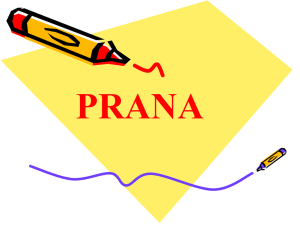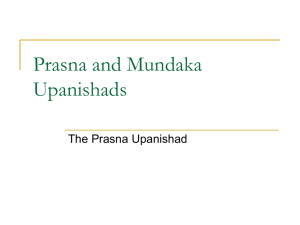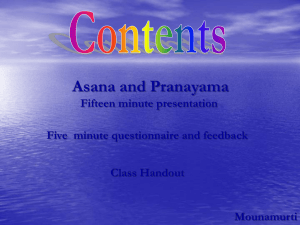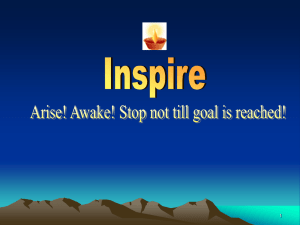PRANA AND THE VAYUS
advertisement
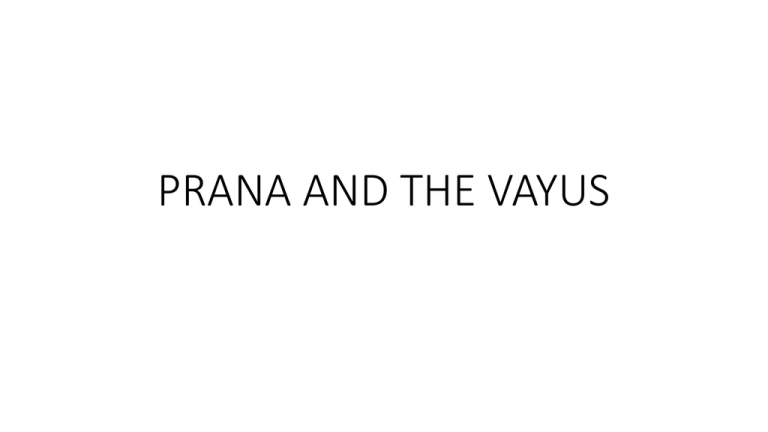
PRANA AND THE VAYUS WHAT IS PRANA? • Prana with a capital P – life force, vital force, animating principle, without Prana there is no life. Originates outside the body • Gives vitality and strength • Provides the link between the physical body and the energetic bodies/astral body. When this link is lost, death results • Associated with the sun, all pervading. Exists in both macrocosm and microcosm • The same energy from the same force, but manifests in different forms MORE ABOUT PRANA • - that which is/goes everywhere, in all beings, in earth and rocks. • - flows through the nadis whose gateway is the nostrils. • 2 main channels in yoga: Left nostril = ida nadi and right nostril = pingala. Central channel sushumna • According to the Prashna Upanishad, ‘Everything rests in prana.’ (Easwaran, E (1987). The Upanishads, p229.) The readings build an image of prana as burning like fire and blowing like wind, having form and yet no form and states, ‘Prana is immortality’. (Easwaran, E (1987). The Upanishads, p229.) Prana and the Breath • Prasna Upanishad –prana “issues out of the mouth and nostrils, resides in the eyes and ears”. In other words, it is manifest in the breath and animates the sense organs. However it is NOT the breath itself. The confusion arises because we need the breath to survive and we can manipulate the Prana through pranayama. • Desikachar in Heart of Yoga says that Prana enters the body in the moment when there is a positive change in the mind, occurring over a long period of time. It does not simply flow into us when we inhale. • We cannot acquire more prana from the outside, by breathing it in, for example. When allowed to flow correctly, then we have conditions for optimum functioning. • Breath is the expression of Prana, the expression of life and the force behind it. KAUSHITAKI UPANISHAD • Life is prana, prana is life. So long as prana remains in this body, so long is there life. Through prana, one obtains, even in this world, immortality. • In yoga we are trying to influence the flow of prana through our breath because, ‘the quality of our breath influences our state of mind and vice versa. In yoga we are trying to make use of these connections so that prana concentrates and can freely flow within us.’ (Desikachar, T.K.V (1995). The Heart of Yoga. p 55.) In simple terms, as Desikachar explains, the more content a person is or the better they feel is an indication of the amount of prana they have inside them. The opposite is also the case, that a person who is disturbed is one whose prana has been dissipated and lost. VAYUS THE 5 LIFE FORCES OF THE BODY • Prana (with a capital P) enters the body through the vehicle of the breath • However, there are movements of prana WITHIN the body • They are called Vayus – meaning vital air or life energies. In several Upanisad, vayu is referred to as the deity of the wind, the god of the air. They are said to govern the natural elements. In the Ramayana, of which the Bhagavad Gita forms part, Hanuman was the son of Vayu, the air god, and could thus leap across the expanse of water separating India from Sri Lanka. • The vayu are concerned specifically with the pranamaya kosha THE KING RULES THE KINGDOM • AND appoints officers to reside over the different areas of the kingdom, so each of the vayus governs an area of the body. Each has a responsibility for a different function in the human body and the flow of energy within that area. Remember each vayu is interdependent and interconnected.l • The Prashna Upanishad creates imagery of the vayus in our body as the fires of prana burning in different directions for a specific purpose for example, ‘Apana is like the holy hearth-fire/Ever burning in the householder’s shrine; Vyana is like the fire that faces south/For carrying offering to our ancestors.’ (Easwaran, E (1987). The Upanishads, p233). CHANDOGYA UPANISAD • On what are you (body and senses) and yourself (soul) supported? • On prana • On what is prana supported? • On apana • On what is apana supported? • On vyana • On what is vyana supported? • On samana • What enters the body is called prana • What leaves is called apana and too much apana can prevent prana from entering so they must be in a state of balance to be effective • The practice of yoga aims to reduce these impurities. We have to reduce the apana so that we can bring more prana into the body. (Desikachar, T.K.V (1995). The Heart of Yoga. P57.) We can do this simply through pranayama. When we inhale we draw in prana from outside the physical body. During the inhalation prana meets apana. When we exhale the apana within the body moves towards the prana, ‘Pranayama is the movement of the prana toward the apana and the movement of the apana toward the prana.’ (Desikachar, T.K.V (1995). The Heart of Yoga. p 58.) • Agni relates to the metabolic fire in the body situated in the navel area. ‘Agni, fire, is the presiding element of the navel centre, a pivotal point of pranic energy—energy that links body and mind. It is through the various subdivisions of prana, functioning in coordination with the navel center, that the body is nourished and sustained.’ (Anderson, S. (2011) Agni Sara, Building Core Strength). Kumbhaka or breath retention in pranayama encourage apana to get rid of the burnt waste and remove blockages as do certain asanas, such as inversions. BIBLIOGRAPHY • Windows into the Infinite Barbara Powell Jain Publishing • The Yoga Book Stephen Sturgess Motilal Pubs. • The Yoga Tradition Georg Feuerstein Hohm Press • Gheranda Samhita S.C.Vasu Satguru Pubs • Heart of Yoga TKV Desikachar • Hatha Yoga Pradipika Swami Muktibodhananda Bihar Pubs
